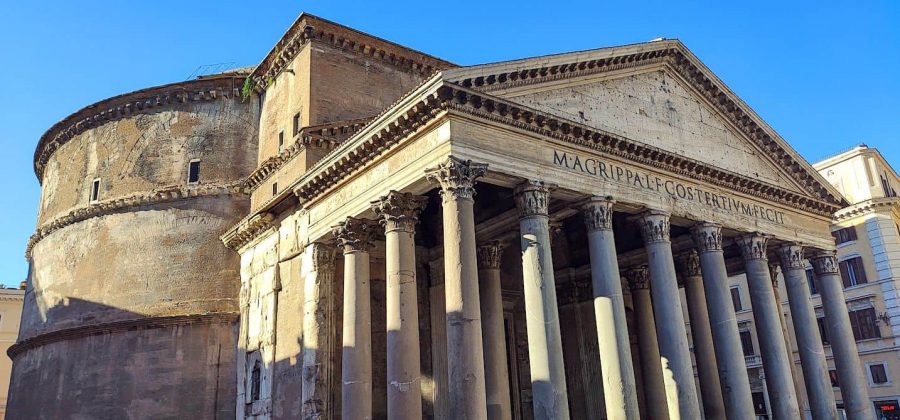The Pantheon, an architectural wonder that has stood the test of time for nearly two millennia, continues to astound visitors with its grandeur and ingenuity. While its massive dome and oculus are well-known features, there are numerous lesser-known architectural marvels hidden within this ancient Roman masterpiece. In this article, we’ll explore ten of these hidden gems that showcase the brilliance of Roman engineering and design.
1. The Perfect Sphere
While many visitors are aware of the Pantheon’s impressive dome, few realize that it forms a perfect sphere. The interior height of the dome is exactly equal to its diameter, creating a harmonious balance that has inspired architects for centuries. This perfect proportion is not just aesthetically pleasing but also contributes to the structure’s stability.
2. The Cleverly Disguised Weight-Reduction Technique
Look closely at the dome’s interior, and you’ll notice a series of sunken panels known as coffers. While these add a decorative element to the ceiling, their primary purpose is far more practical. The coffers significantly reduce the dome’s weight without compromising its structural integrity, a brilliant solution to the engineering challenge of supporting such a massive roof.
3. The Ingenious Drainage System
The Pantheon’s floor isn’t just a flat surface. It’s slightly convex, rising about 30 centimeters (12 inches) at its center. This subtle dome shape, combined with cleverly placed drainage holes, allows rainwater entering through the oculus to flow away efficiently, preventing water accumulation and potential damage to the structure.
4. The Hidden Tension Ring
At the base of the dome lies a hidden architectural marvel – a tension ring. This ring, made of bronze and embedded within the concrete, helps distribute the dome’s enormous weight evenly. It’s a crucial element in preventing the dome from collapsing outward, yet it remains invisible to the casual observer.
5. The Graduated Thickness of the Dome
The Pantheon’s dome isn’t uniformly thick. In fact, its thickness gradually decreases from bottom to top. At its base, the dome is about 6 meters (20 feet) thick, while at its apex near the oculus, it’s only about 1.2 meters (4 feet) thick. This graduated thickness reduces weight at the top while maintaining strength at the base, another example of Roman engineering prowess.
6. The Precise Alignment of the Oculus
The oculus, the 8.8-meter (29-foot) diameter opening at the top of the dome, isn’t just a skylight. It’s precisely aligned so that during the spring equinox, a shaft of light illuminates the Pantheon’s main entrance at midday. This alignment demonstrates the Romans’ advanced understanding of astronomy and their attention to symbolic details in architecture.
7. The Sophisticated Concrete Mix
The Pantheon’s dome is made of an ingenious concrete mixture that gets progressively lighter towards the top. The Romans achieved this by mixing in lighter aggregates, such as pumice, as they built higher. This gradual change in density allowed for the construction of such a large dome without compromising its stability.
8. The Optical Illusion of the Interior
The interior of the Pantheon creates an optical illusion that makes the space appear larger than it actually is. This effect is achieved through the careful proportioning of architectural elements and the strategic placement of niches and columns. The result is a sense of awe-inspiring vastness that continues to captivate visitors today.
9. The Hidden Buttresses
While flying buttresses became popular in later architectural styles, the Pantheon employs a more subtle approach. The thick walls of the rotunda act as internal buttresses, distributing the weight of the dome evenly. This innovative design allows for a spacious interior while maintaining structural integrity.
10. The Mortar-Free Portico
The Pantheon’s massive portico, with its 16 monolithic granite columns, holds a secret: it was constructed without the use of mortar. Instead, the Romans used a sophisticated system of clamps and dowels to hold the stones together. This technique has contributed to the portico’s longevity and resilience against earthquakes.
Conclusion
The Pantheon stands as a testament to the ingenuity and architectural prowess of ancient Rome. These hidden marvels reveal the depth of thought and skill that went into its design and construction. From its perfect proportions to its innovative use of materials and clever engineering solutions, the Pantheon continues to inspire and amaze nearly two millennia after its construction.
As you plan your visit to this architectural wonder, keep these hidden marvels in mind. They add layers of appreciation to your experience, transforming a simple sightseeing trip into a journey through the brilliance of ancient Roman engineering. Book your Pantheon tickets today and prepare to be astounded by both the obvious and the subtle wonders of this enduring masterpiece.
